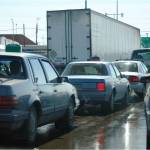05 Nov The trouble with trucks

The trouble with trucks is not necessarily the trucks.
According to the Insurance Institute for Highway Safety (IIHS), about 10 percent of highway deaths involve a large truck but 70 percent of the victims are in a passenger vehicle. When the two collide, there really is no contest but there’s plenty of blame to go around when you consider that passenger vehicles far outnumber large trucks.
Large trucks weigh about 20 to 30 times more than the average passenger car and have greater height which can compound both the safe control of a truck as well as allow smaller vehicles to be sheared off when skidding beneath them.
Truckers often take the brunt of the blame for accidents but the data says it is passenger car drivers most often at fault. According to the Federal Highway Administration, the car driver’s behavior was more than three times as likely to contribute to the fatal crash than was the truck driver’s behavior. In addition, the car driver was solely responsible for 70 percent of the fatal crashes, compared to 16 percent for the truck driver.
What can you do to reduce a truck-related mishap?
REMAIN VISIBLE: The sticker on many well-maintained tractor trailers is the biggest single caution of all: IF YOU CAN’T SEE ME, I CAN’T SEE YOU. Think of your own near-misses in parking lots when backing up. If you fail to check all your mirrors, often you miss seeing poles, signs, other vehicles or pedestrians.
THREE SECOND RULE: At one time or another, we’ve all been guilty of tailgating. The easiest way to determine a safe distance on dry pavement is to pick a spot the vehicle in front you has just passed and count to three. If you reach the same in less time, BACK OFF.
MIRROR LANE CHANGE: After passing a vehicle, particularly a truck, pull back into the travel lance once you can see both headlights of the passed vehicle in your rearview mirror. And, once you are back in the lane maintain speed so as not to force the passed vehicle to brake. If you cause a truck to hit the brakes, the driver behind the truck will have little warning should they need to brake as well.
DO NOT PASS ON THE RIGHT: Whether in the city on the highway, always pass a truck on the left, particularly when approaching an intersection. Trucks that turn right need a wide angle to bring their trailer safely through the turn.
MOVE ON DOWN THE ROAD: Once you have committed to pass a large truck, do not travel along side it for any distance – pass it as quickly and safely as possible. Large trucks create air currents that can jostle a smaller vehicle. In addition, if you ride along side, you are boxing the trucker from a safe route the driver needs to avoid traffic ahead.
CLEAR WINDSHIELDS: Throw a little rain or snow on the road and the relationship of cars to trucks gets even more challenging. A slick road surface not only means slower stopping but also more issues with visibility. As winter weather approaches, be sure your windshield wipers are good to go and that your wiper fluid is amply full.
Let’s all share the road at a safe distance and live to ride another day.



